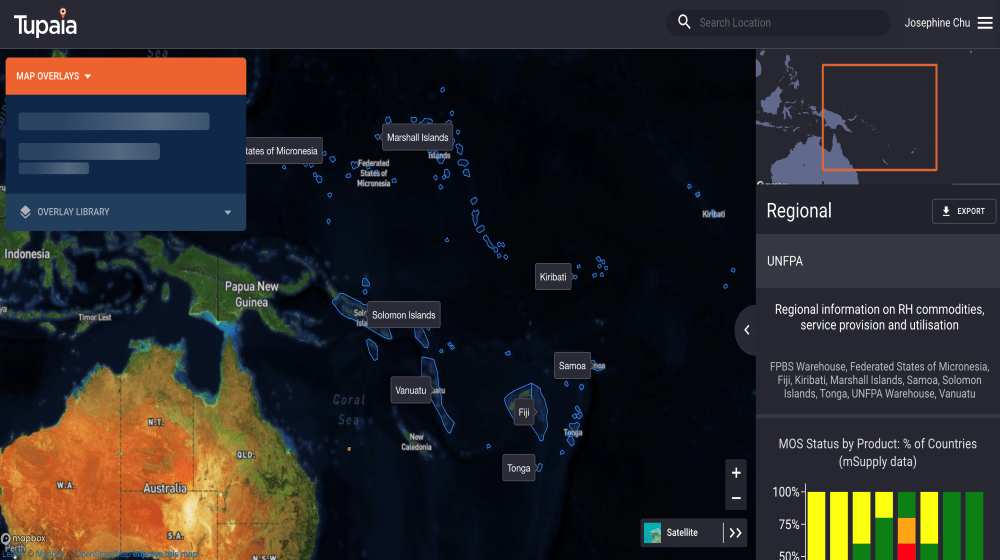The world’s population has reached 8 billion. This is a milestone for humanity and a moment for reflection, including for the Small Island Developing States such as the Pacific countries, because the reproductive health and rights (SRH) of women and girls must be protected irrespective of demographic trends, to enable the whole communities and countries to thrive.
In order for governments to protect their fellow citizen women’s and girls’ reproductive health and rights – by reaching the furthest behind first and leaving no one behind – they need to first know exactly who have SRH needs, what kinds of SRH needs they are, where they reside and so forth. This is why the availability of real-time, disaggregated, high-quality data is critically important for national and local policy-makers, planning and budget officers. And so is ‘visualization’ of such data for ease of their use.
To assist Pacific Small Island countries in this endeavor, the United Nations Population (UNFPA) Pacific has been contributing digital solutions. One is Tupaia, a customisable digital platform managed by Beyond Essential Systems (BES), which is now used by governments and partners across the Pacific to aggregate and visualise data regarding reproductive health services and commodities. This is in support of the UNFPA Supplies Partnership and UNFPA’s ‘Transformative Agenda for Women Adolescents and Youth in the Pacific’ Programme funded by Australia’s Department of Foreign Affairs and Trade (DFAT), which has so far been implemented in six countries: Fiji, Kiribati, Samoa, Solomon Islands, Tonga and Vanuatu.
In Tupaia, data is coming in from multiple sources including UNFPA-supported Health Facility Readiness and Service Availability Assessments, spot-checks of health facilities, and training data, to populate visuals showing information important for planning and budgeting for reproductive health services. The dashboards make it possible for users at the regional, national, and sub-national levels to review data, even drilling right down to the facility level. Tupaia thus strengthens supply chain management and enables government officials and development practitioners to target services and resources for sexual and reproductive health to the areas of the greatest need.
Another digitalisation effort employed by UNFPA Pacific and governments across the region is mSupply, an electronic logistics management information system used to streamline supply chain processes throughout procurement, forecasting, warehousing, distribution and reporting.
UNFPA Pacific has set up the ‘UNFPA Supplier Hub’ that links the mSupply system within UNFPA Pacific to the mSupply systems of the central warehouses based in Fiji, Kiribati, Solomon Islands, Tonga and Vanuatu. Through the UNFPA Supplier Hub, countries can place orders directly with UNFPA in a matter of seconds. This digitalisation effort has expedited the ordering process and made it easier for governments to receive and record stock upon arrival. The tool also calculates information such as average monthly consumption and generates reports for decision-making.
Mr. Samuela Tuisavura, Warehouse Operations Manager, Fiji Pharmaceutical & Biomedical Services Centre (FPBSC), Ministry of Health and Medical Services, is among many health officials in the Pacific region who are taking advantage of a variety of features and functions that the UNFPA-supported mSupply application offers. “I like the real time data that mSupply generates to help us make decisions quickly,” said Mr. Tuisavura.
Before the implementation of the mSupply application, there were only four health facilities for which the Ministry was able to track the inventory activities, including the three Divisional hospitals. In contrast, now with mSupply, logistics data is becoming available right down to the remote and lowest level health facilities and nursing stations.
“mSupply is not only helpful to the Ministry of Health and Medical Services. It is beneficial to the whole population of Fiji because it visualizes which medical supplies are readily available now, and where. mSupply is a simple, efficient and user friendly application,” says Mr. Tuisavura. He explains the benefits and utility of this application, adding that “Generating reports about near-to-expiry, or expired items, and slow-moving stocks in the warehouse used to take a while, in the past. But with the mSupply application, it now takes me only 2-3 minutes to produce.” mSupply is also linked to Tupaia to enable the display of stock on hand information at any level of the supply chain that uses mSupply.
With the global population reaching 8 billion including 2.5 million in the 14 Pacific Island Countries and Territories that UNFPA Pacific serves, the use of innovative digital solutions, such as Tupaia and mSupply, will assist Pacific governments to safeguard the availability and quality of sexual and reproductive health medicines and services, ensuring no one is left behind. Women who have reproductive choices and access to health services are more empowered to pursue education, seek and keep better jobs, contribute to household income, and lift families out of poverty, thus contributing to further socio-economic development of her community and country as a whole.
“Empowering women to manage their sexual and reproductive health is an investment that benefits everyone. Therefore, investment on accurate and easily accessible information about their sexual and reproductive health and rights benefits all as well,” says Iori Kato, UNFPA Director for the Pacific and Representative in Fiji.


